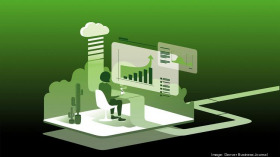- October 3rd, 2022
- 0 Comments

Last week, an editor from The National Observer reviewed the latest 2021 American Community Survey data from the U.S. Census Bureau which includes metrics showing how much work-from-home has increased since the Covid-19 pandemic. Key observations include:
- Between 2019 and 2021, the number of people primarily working from home tripled from 5.7% to 17.9% (or about 9 million people to roughly 27.6 million people)
- That correlated with a drop in commute time, as well, with the average one-way travel time to work dropping from 27.6 minutes in 2019 to just 25.6 minutes in 2021 – among the shortest times in the past decade
The Business Journals drilled further into the work-from-home data, comparing one-year estimates from the Census' 2019 survey to that of 2021, as well, to find that geographically, some of the nation's economic powerhouse metropolitan areas are also seeing the biggest increases in work from home since the pandemic. They also note, however, that case-count spikes during 2021 may still be impacting the conclusions drawn from statistical data and may not fully reflect what's now happening in 2022.
The biggest share of survey respondents working from home was from Boulder, CO where data spiked from 13.7% working from home in 2019 to 36.3% in 2021. San Fransisco also saw a dramatic increase – from 7.2% in 2019 to 35.1% in 2021, and nearby San Jose, California, went from just 4.2% in 2019 to 34.8% in 2021. More data for 2022 and ensuing years will be necessary to determine how far a reach working from home will continue to have in markets nationally, but it's increasingly clear that one of the biggest permanent changes from the pandemic is the adoption of remote work.
Washington, D.C., is a particularly illuminating example – with the share of remote workers in the District itself going from just 7.4% in 2019 to a whopping 48.3% in 2021 – more than any other area represented by the statistical data.
If the trend sticks, these higher shares of remote workers will have outsized ripple effects on office space vacancy and demand. It's not certain whether physical office occupancy will continue to rise in the coming weeks, but observers of the U.S. office market and return-to-office believe this year's post-Labor Day office-using activity will be the first true indicator of what permanent post-pandemic office usage will look like.













